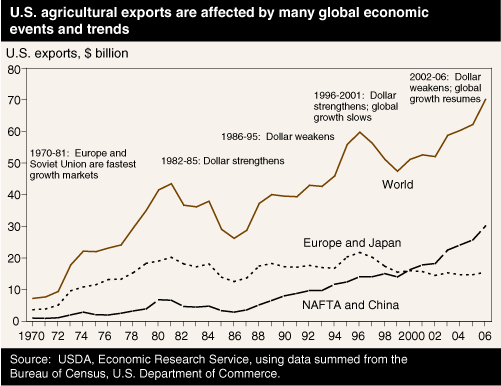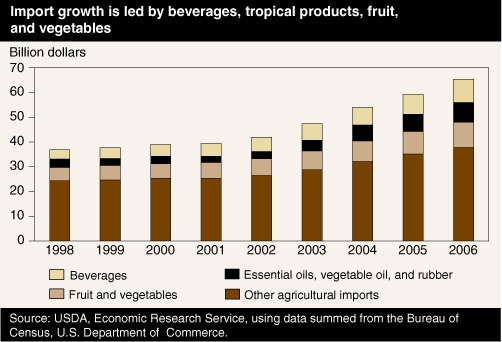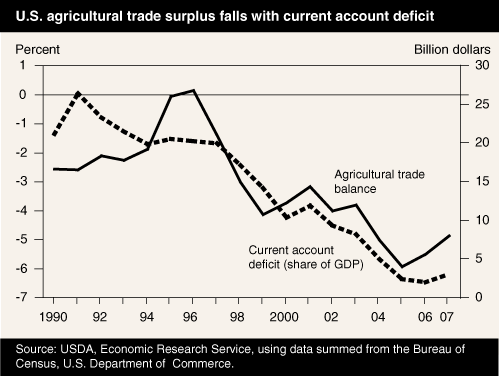U.S. Trade Growth: A New Beginning or a Repeat of the Past?
- by Erik Dohlman and Mark Gehlhar
- 9/3/2007
Highlights
- After faltering for several years, U.S. agricultural export growth isexperiencing a renewal, sparked by rising food demand in emerging markets, a weakening dollar, and closer integration with NAFTA partners.
- Import growth has also been unusually strong as a result of regional integration (NAFTA), consumer preferences for foreign products, and strong overall growth in consumer spending.
- Continued growth in emerging markets combined with macroeconomic factors at home points to sustained growth in U.S. exports and slower import growth.
Fast-rising imports and a stretch of slow export growth reduced the U.S. agricultural trade surplus from a 1996 record of $27.3 billion to less than $5 billion a decade later. But changes in the structure of U.S. trade in recent years have brought renewed export demand and signs of slower import growth, signaling a potential reversal of recent trends. U.S. agricultural exports in fiscal year (FY) 2007 are in the fourth consecutive year of record shipments, buoyed by rising foreign demand, competitive U.S. prices resulting from a weaker dollar, and strong world growth. Despite the weaker dollar, imports are still growing rapidly, but not quite as fast as in some recent years.
The simultaneous growth of U.S. agricultural exports and imports are both linked to regional integration and freer trade with Canada and Mexico; however, there are also other separate and distinct factors shaping imports and exports. While a weaker dollar has helped exports in recent years, sustained changes in export performance hinge upon global economic and population growth trends and shifts in demand between foreign markets. An ongoing transition in global food import demand from mature high-income countries to more dynamic emerging markets, for example, played a key role in precipitating first the slowdown of U.S. exports in the mid-1990s and now the current expansion. U.S. import growth, on the other hand, is not strongly associated with domestic income and population growth. Nor has it responded quickly to rising prices caused by the weaker dollar. Instead, it seems more closely tied to changing consumer preferences and macroeconomic conditions that have stimulated the vast U.S. current account deficits of recent years, now at an unprecedented level of 7 percent of Gross Domestic Product (GDP). The current account balance reflects not only the value of trade in goods and services, but also the value of net investment earnings to and from the rest of the world—providing the broadest measure of U.S. borrowing from the rest of the world.
Can Recent Export Growth Be Sustained?
Income, population, and the rate of economic growth in importing countries have long been recognized as key determinants of foreign demand for U.S. agricultural products. Many analysts expected the rapid growth in U.S. exports in the mid-1990s to continue, for example, based largely on increased demand from fast-growing emerging markets. However, analysts did not foresee a decline in demand from high-income markets. In Japan and the European Union (EU), relatively slow growth in income and population helped induce a drop in demand for U.S. food products. In 1996, these two markets accounted for $21 billion (35 percent) of U.S. agricultural exports, but by 2006, the total was less than $15.3 billion (22 percent). A low propensity for consumers to spend additional income on food, aging populations (with reduced dietary needs), and, until 2002, an appreciating dollar also helped dampen export demand. These factors accentuated the effects of trade barriers, such as relatively high tariffs, which have limited new access for U.S. agricultural products.
So what explains the renewed growth of U.S. exports? In addition to the weakening dollar, a key factor is that demand from emerging markets is having an appreciable impact on both global food demand and U.S. exports. Emerging markets contributed to the growth of global and U.S. food trade throughout the 1990s, but gains since 2000 have been far greater. Global agricultural trade expanded less than 25 percent during the 1990s but has already grown 50 percent in the first part of this decade, spurred by rising incomes in emerging markets. As a result, the share of U.S. exports destined for emerging markets climbed from 30 percent during the early 1990s to 43 percent in 2006. China and Mexico now account for 25 percent of U.S. exports—nearly triple their share in 1990. Exports to China alone are now nearly equal to exports to the EU. Overall, U.S. exports are up from $50.7 billion in FY 2000 to a projected $78 billion in FY 2007.
Although U.S. exports always have ebbed and flowed, there are a number of reasons to believe that the increased prominence of emerging markets in global food trade could lead to sustained export growth. In the past decade, the emerging market share of global GDP has risen from 43 percent in 1996 to 50 percent in 2006 (as measured by “purchasing power parity” rather than exchange rates), and the emerging market share of global trade has climbed at an even faster pace. Developing regions such as China, Southeast Asia, Mexico, Central America, and India will likely continue to increase their share of global GDP in the coming decades. They will also account for 95 percent of the expected increase of 1 billion persons to the global population by the year 2020. Despite generally higher agricultural commodity prices brought on by the expansion of ethanol production in the U.S., enhanced spending power abroad is projected to substantially raise the value of U.S. agricultural exports over the next decade—from $69 billion in 2006 to $95 billion by 2016, according to USDA projections.
Food expenditure shares will also factor into sustained growth of agricultural exports. Food purchases represent a much larger share of new expenditures in developing countries than in high-income markets. For example, for every additional dollar of income, consumers in Egypt, Indonesia, and Vietnam spend more than 25 cents on food, while consumers in France, Japan, and the United States spend less than 10 cents. It will take decades for the developing countries to reach a level of development where food demand becomes saturated.
The larger proportion of young people in developing countries is another indicator suggesting sustained demand growth. Slowing economic growth and food demand is associated with an aging, high-income population, and food demand tends to taper off as the population matures, even while per capita incomes may rise. Less than 15 percent of the population in Japan and Europe is under 14 years old, in contrast to roughly a third of the population in India and Mexico.
ERS analysis of historical changes in U.S. agricultural trade also suggests that the shift of U.S. exports to regional partners with open markets and more durable demand helped to sustain recent export growth, as seen over the past 5 years. The unwavering demand from North American Free Trade Agreement (NAFTA) partners is providing continuity for U.S. agricultural exports that was missing from other lead markets (Japan and Europe) in previous decades. Canada and Mexico are now the two top markets for U.S. exports, expected to generate a combined $26 billion in demand for U.S. agricultural products. Due to Canada’s comparatively slow population and income growth, the pace of U.S. exports to Canada may eventually subside. However, exports to Mexico will most likely continue to show strong growth and will enable Mexico to overtake Canada as the leading market for U.S. agricultural products, due to Mexico’s higher rates of income and population growth.
Trade agreements, the strength or weakness of different currencies, and unpredictable market developments for particular commodities (e.g., the disruption of U.S. beef exports to Japan following the discovery of bovine spongiform encephalopathy in U.S. cattle) will affect the evolution of U.S. trade flows in individual markets. The differences among countries reflect the contrasting effects of trade liberalization in some markets (NAFTA and China’s World Trade Organization (WTO) accession) and exchange rate rigidities and trade barriers in others. Nevertheless, ERS research indicates a strong connection between foreign economic growth and overall U.S. agricultural exports, and suggests that if economic growth continues at the recent pace in emerging markets it should help sustain U.S. export growth for the foreseeable future.
Research also indicates, however, that the rapid pace of U.S. imports in recent years is not well explained by domestic economic growth and population change. Actual import growth dwarfed levels projected by these factors especially since 2001, indicating that other forces have been at play.
What Lies Behind the Rapid Growth of U.S. Imports?
U.S. agricultural imports doubled in the past decade to a record $64 billion in FY 2006. Since 2001, U.S. import growth has averaged more than 10 percent per year, far above the long-term trend and similar to import growth in some of the fastest growing emerging markets. This upward surge comes even as the U.S. dollar has depreciated, which, other things equal, should curb imports by making them more expensive (see “The Role of Exchange Rates”). In 2007, import growth appears to have lost some momentum, compared with that of the previous 4 years, with annual growth currently below 10 percent.
One fundamental cause for the growth in U.S. imports appears to be the combined effects of regional integration promoted by NAFTA and increased consumer preference for a wide variety of imported foods. The largest absolute and percentage gains in imports have come from NAFTA partners Mexico and Canada. For example, the U.S. has been an attractive market for live animal imports from Canada with its efficient large-scale slaughter operations. Both live animals from Canada and U.S. meat exports to Mexico have grown rapidly in recent years. The United States is also sourcing much of its off-season demand for fruit and vegetables from Mexico and the Southern Hemisphere. Reflecting the diversity and affluence of U.S. consumers, the largest increases in U.S. imports since the early 1990s are attributed to such products as confectionery, beer and wine, and fruit and vegetables.
The accelerated growth of agricultural and food imports in the U.S. is also connected to the same macroeconomic conditions that spurred a dramatic rise of U.S. merchandise trade and current account deficits. Over much of the past decade, conditions in the U.S. economy encouraged strong consumer spending, leading to rapid, across-the-board growth in imports. Although the dollar has depreciated since 2002, U.S. spending on imports has remained strong, and in 2006, the U.S. current account deficit reached a record $811 billion (7 percent of GDP)—up from $100 billion in 1996. Imports of all categories of goods have grown at a brisk pace—most notably consumer goods, but also services and agriculture—categories in which the U.S. remains a net exporter. Thus, the recent changes in U.S. agricultural trade appear to be part of an economy-wide phenomenon.
Recent economic literature associates the overall growth in U.S. imports with such factors as the increased wealth of U.S. households, low domestic savings rates, strong consumption growth, and foreign demand for U.S. financial assets. The stock market appreciation in the 1990s and housing sector wealth gains in the current decade encouraged U.S. consumers to draw upon their equity, reduce their savings, and spend more on both domestic and imported goods. At the same time, growing inflows of foreign capital kept interest rates low and prevented the dollar from declining further. The unprecedented size of the U.S. current account deficit has sparked widespread debate about the capacity to sustain such levels and the implications of a potential adjustment.
Many Factors Influence U.S. Trade Prospects
To better understand the current shifts in U.S. agricultural trade, ERS focused on the implications of mounting U.S. current account deficits and examined the effects of potential changes that may place downward pressure on the U.S. dollar and consumption. A model of the U.S. economy simulated the impacts of reduced foreign willingness to purchase U.S. financial assets such as Treasury securities (these purchases, while made as investments, also represent lending to the United States used to finance the current account deficit).
During the past decade, foreign investors have become increasingly attracted to secure, but relatively low-return, U.S. investments. Given the importance of foreign capital inflows (lending) to the U.S., a central concern is that improved investment prospects elsewhere or a desire for currency diversification could reduce the willingness of foreign investors to hold U.S. financial assets. Lower demand for dollars would lead to further dollar depreciation, more subdued U.S. consumption growth, and lower overall deficits—all of which should raise net U.S. agricultural exports.
For example, capital inflows may eventually subside if less developed economies, which account for a large share of foreign lending to the U.S., choose to invest their savings elsewhere. According to conventional economic theory, less advanced economies would typically offer higher, albeit more volatile, rates of return on investments because capital in these countries is relatively scarce. A more stable investment climate could encourage investors from emerging economies to redirect their savings to investment opportunities in their own or other emerging economies. A desire to diversify currency holdings could also motivate a shift in assets from the U.S. to other economies. Korea, Japan, and China, among other top holders of dollar-denominated foreign currency reserves, have all hinted at the possibility of diversifying their foreign exchange reserves.
Analysts can only speculate about a sudden downturn in demand for U.S. financial assets, but should it occur, it would most likely trigger further depreciation of the dollar and higher interest rates. A weaker dollar would tend to raise foreign demand for U.S. exports of agricultural (and other) products because the price of U.S. goods would be cheaper in foreign currency terms. Similarly, the price of foreign products would increase for U.S. consumers, eventually dampening import growth. Higher interest rates in the U.S. would reinforce these tendencies if they result in reduced borrowing and spending on both imported and domestically produced agricultural products.
ERS research suggests that a 20-percent depreciation of the U.S. dollar could increase export volume by as much 13 percent and decrease import volume by somewhat less than 10 percent, compared with projected levels without this depreciation. This occurs because exports become less expensive for foreign purchasers, while imports become more expensive for U.S. domestic consumers. Imports would also be affected by a slowing of consumption growth, which is essential because recent experience demonstrates exchange rate depreciation by itself may not slow import growth.
Between 2001 and 2006, for example, the value of U.S. agricultural imports from the EU accelerated despite a substantial depreciation of the dollar against the euro (and some other currencies). The reason may be that U.S. demand for many imported products is price inelastic—that is, a given price change induces a relatively small change in quantity demanded. In fact, the continued strength of U.S. consumption boosted the quantity of imports, which translated into an even larger increase in value terms due to the weaker dollar. Impacts of exchange rates on U.S. agricultural exports and imports also depend on which foreign markets experience the greatest exchange rate changes, delays in purchasing behavior by importers and exporters, and the degree to which exchange rates are passed through to buyers.
Although many other factors will influence agricultural trade prospects, shifts in foreign economic growth and macroeconomic influences potentially point to sustained growth of U.S. agricultural exports and slower growth of U.S. imports. The U.S. food sector encompasses a broad and diverse set of interests, but these new developments would be positive for stakeholders involved in agricultural production, belying the attention given to the recent narrowing of the agricultural trade balance. The fact that U.S. agricultural exports and farm income levels have been historically strong in recent years demonstrates that a declining trade balance is not necessarily an indicator of lower demand or reduced returns to stakeholders in the sector. Strong consumption growth and the desire for a wide variety of foods and beverages may continue to spur import growth, but imports remain a relatively small share of domestic food consumption.
This article is drawn from:
- Gehlhar, M., Dohlman, E., Brooks, N., Jerardo, A. & Vollrath, T. (2007). Global Growth, Macroeconomic Change, and U.S. Agricultural Trade. U.S. Department of Agriculture, Economic Research Service. ERR-46.
You may also like:
- Foreign Agricultural Trade of the United States (FATUS). (n.d.). U.S. Department of Agriculture, Economic Research Service.
- U.S. Agricultural Trade. (n.d.). U.S. Department of Agriculture, Economic Research Service.
- International Macroeconomic Data Set. (n.d.). U.S. Department of Agriculture, Economic Research Service.
- Agricultural Exchange Rate Data Set. (n.d.). U.S. Department of Agriculture, Economic Research Service.
- Weaker Dollar Strengthens U.S. Agriculture. (2007). USDA, Economic Research Service. in Amber Waves, Vol. 5, Issue 1..
We’d welcome your feedback!
Would you be willing to answer a few quick questions about your experience?




